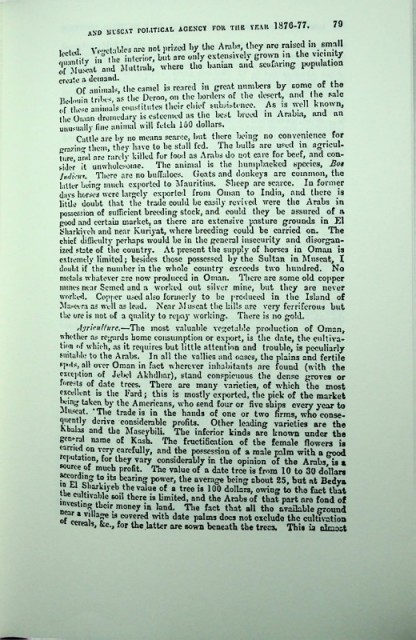Page 327 - PERSIAN GULF ADMINISTRATION REPORTS V1
P. 327
yf.au 1370-77. 79
POLITICAL AGENCY FOtt THE
AND MUSCAT
, , l Wret iblcs arc not prized by the Arabs, llioy are raised in small
IcctoO. intcriorj but arc 0„iy extensively grown m the vicinity
of Mu^nl and Multrah, where the baman and seafaring population
create a demand.
Of animals, the camel is reared m great numbers by some of the
Bedouin tribes, as tl.c Deroo, on the borders of the desert, and the sale
of" animals constitutes their chief subsidence As is well known,
tlie Oman dromedary is esteemed as the best breed in Arabia, and an
unusually line animal will fetch 150 dollars.
Cattle are by no means scarce, but there Wing no convenience for
grazin'' them, they have to be shill fed. The bulls are used in agricul
ture, and are rarely killed for food as Arabs do not care for beef, and con
sider it unwholesome. The animal is the humpbacked species, Bos
Jtnlicii*. There are no buffaloes. Goats and donkeys arc common, the
latter being much exported to Mauritius. Sheep arc scarce. In former
da vs horses were largely exported from Oman to India, and there is
little doubt that the trade could be easily revived were the Arabs in
possession of sufficient breeding stock, and could they be assured of a
good and certain market, as there arc extensive pasture grounds in El
Sharkiyoh and near Kuriyat, where breeding could be carried on. The
chief difficulty perhaps would he in the general insecurity and disorgan
ized state of the country. At present the supply of horses in Oman is
extremely limited; besides those possessed by the Sultan in Muscat, I
doubt if the number in the whole country exceeds two hundred. No
metals whatever are now produced in Oman. There are some old copper
mines near Seined and a worked out silver mine, but they are never
worked. Copper used also formerly to be produced in the Island of
Maseera as well as lead. Near Muscat the hills are very ferriferous but
the ore is not of a quality to repay working. There is no gold.
Agriculture.—The most valuable vegetable production of Oman,
whether as regards home consumption or exjiort, is the date, the cultiva
tion of which, as it requires but little attention and trouble, is peculiarly
suitable to the Arabs. In all the vallies and oases, the plains and fertile
sp'ts, all over Oman in fact wherever inhabitants are found (with the
exception of Jebel Akhdhar), stand conspicuous the dense groves or
forests of date trees. There are many varieties, of which the most
excellent is the Fard; this is mostly' exported, the pick of the market
Wing taken by the Americans, who send four or five ships every year to
-Muscat. * The trade is in the hands of one or two firms, who conse
quently derive considerable profits. Other leading varieties are the
hhalas and the Maseybili. The inferior kinds are known under the
general name of Kash. The fructification of the female flowers is
earned on very carefully, and the possession of a male palm with a good
reputation, for they vary considerably in the opinion of the Arabs, is a
source of much profit. The value of a date tree is from 10 to 30 dollars
in pi qi5 ,.lts, bear,n? P°wer, the average being about 25, but at Bedya
L I n* tbe V .e of a tree is 100 doIlara> owing to the fact that
in*^* 8011 there 13 limited, and the Arabs of that part are fond of
Clr.mone^in land* T*10 fact that all tho available ground
of '! o*6 13 covered with date palms docs not exclude the cultivation
eals, &c., for the latter are sown beneath the trees. This is clmoct

